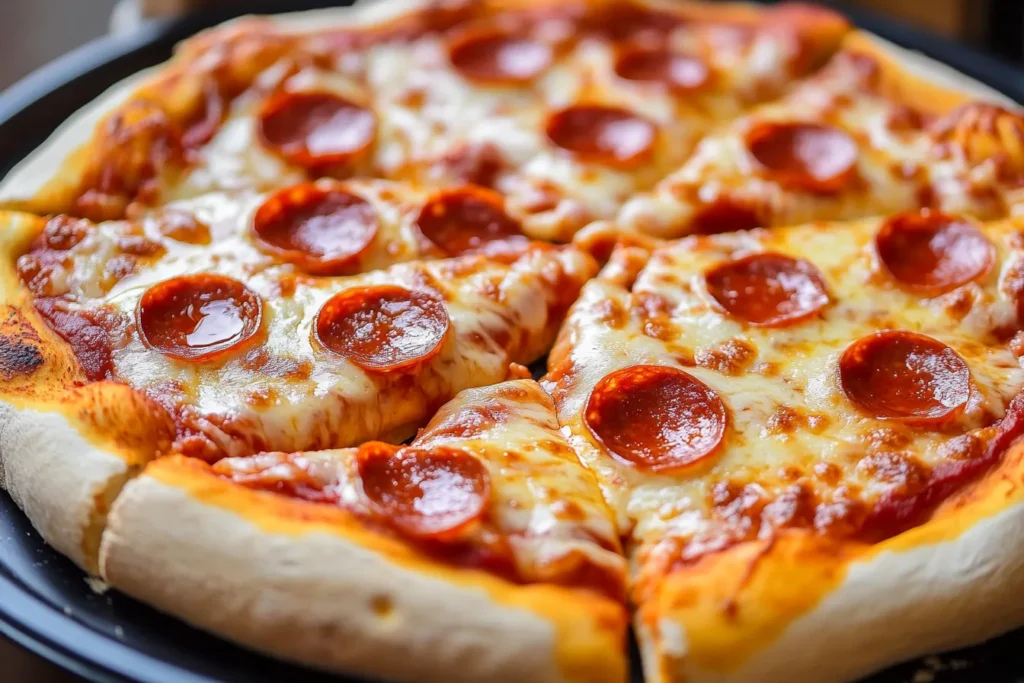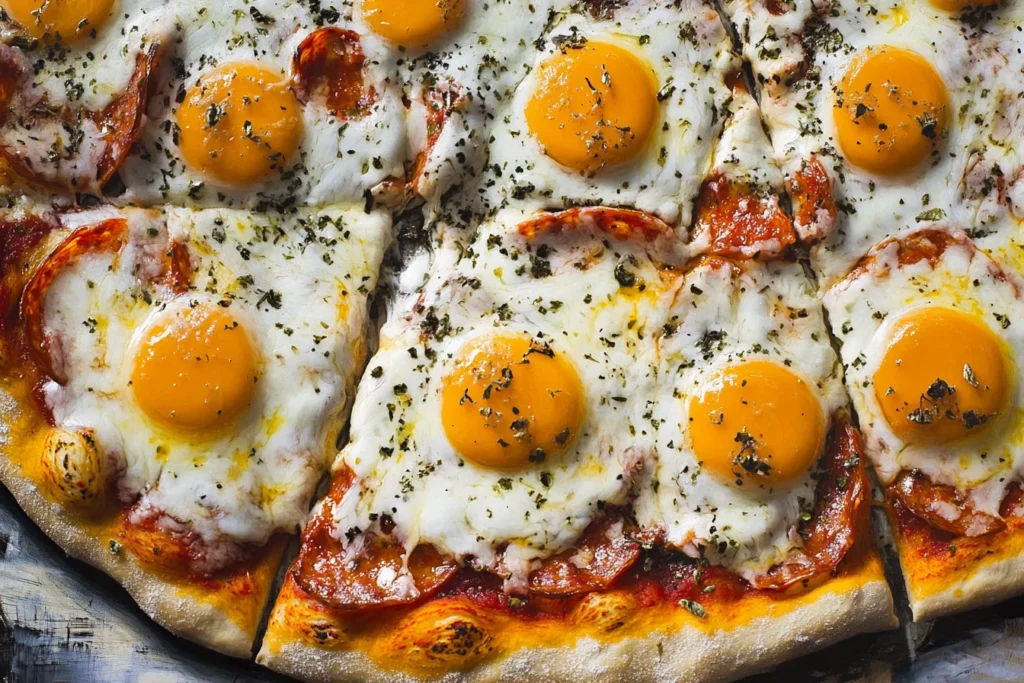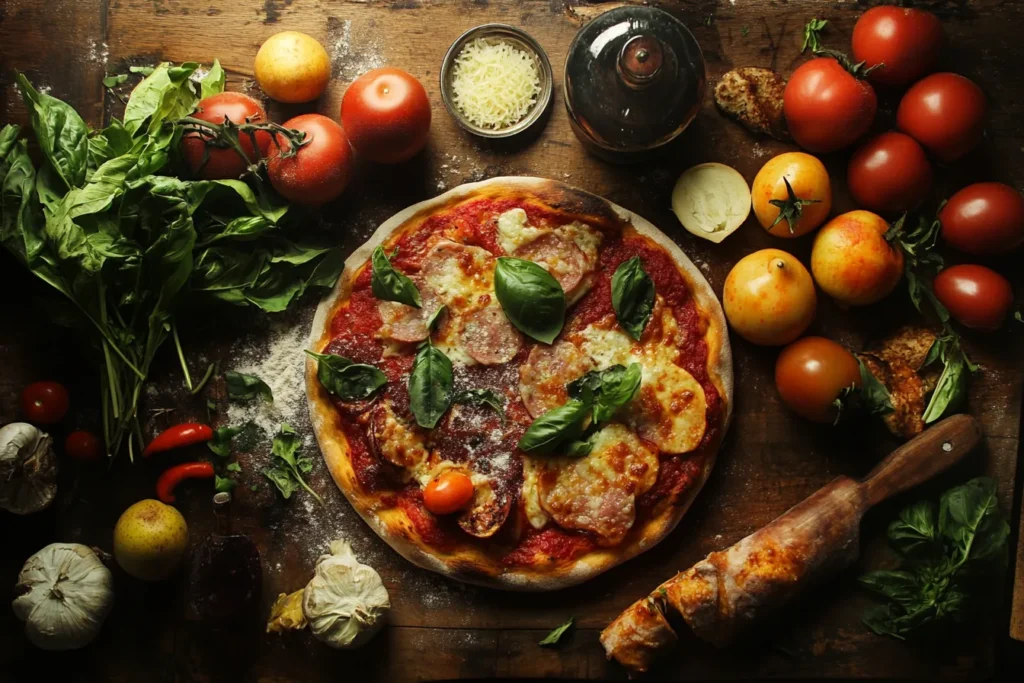Have you ever found yourself craving pizza, only to feel limited by dietary restrictions or health concerns? You’re not alone. For many, finding a pizza that aligns with their lifestyle—whether it’s gluten-free, low-carb, or simply healthier—can feel like an impossible task. But what if I told you that you don’t have to settle for less? Imagine enjoying a delicious, perfectly crisp pizza that checks all the boxes: flavorful, satisfying, and tailored just for you. Whether you’re navigating food sensitivities or just looking to explore new options, this guide will help you bring the joy of pizza back to your table. Let’s get started!
List Of Contents
Introduction
Pizza is a universal favorite, a dish that crosses cultures and preferences. But recently, gluten-free pizza has made its mark, becoming a go-to option for health-conscious individuals and those with dietary restrictions. Why the sudden surge in popularity?
Gluten-free alternatives cater to a growing demographic that values gut health and wellness. But is it merely a trend or a necessity? To unravel this, let’s dive into what gluten-free pizza is all about and whether it’s worth the switch. check out more recipes here.

What Is Gluten-Free Pizza?
To understand gluten-free pizza, you must first know what gluten is. Gluten is a protein found in grains like wheat, barley, and rye. It’s the “glue” that gives traditional pizza dough its elasticity and structure.
So, what makes pizza gluten-free? A gluten-free pizza crust eliminates these grains, using alternatives such as:
- Rice flour
- Almond flour
- Tapioca starch
- Chickpea flour
These substitutes mimic the texture of traditional dough while meeting dietary needs. The result? A base suitable for individuals avoiding gluten.
Some common gluten-free crust ingredients include xanthan gum or psyllium husk to maintain that chewy texture. While innovative, it’s a far cry from the original wheat-based recipe. check out more recipes here.
The Rise of Gluten-Free Diets
In recent years, the gluten-free movement has skyrocketed. But why? The trend can be traced back to a combination of health awareness and increased diagnoses of conditions like celiac disease and non-celiac gluten sensitivity.
This demand isn’t limited to the medical community. People are opting for gluten-free diets as part of broader health trends. Popularity has been bolstered by celebrities endorsing the lifestyle, creating a ripple effect across the food industry. check out more recipes here.
Who Needs Gluten-Free Pizza?
Not everyone needs to steer clear of gluten, but for some, it’s essential. Key groups who benefit from gluten-free pizza include:
- Celiac Disease Patients
For these individuals, gluten triggers an autoimmune response, damaging the small intestine. Even trace amounts of gluten can be harmful. - People with Gluten Sensitivity
Symptoms like bloating, fatigue, and headaches make gluten a no-go for this group. While less severe than celiac disease, it’s still significant. - Health-Conscious Consumers
Beyond medical necessity, some believe gluten-free foods lead to better digestion and reduced inflammation.
How Is Gluten-Free Pizza Made?
Making gluten-free pizza requires creativity and skill. Traditional wheat flour is swapped out for alternatives, and chefs employ various techniques to achieve the perfect crust.
Common Substitutes for Wheat Flour:
- Rice Flour: Offers a neutral flavor and soft texture.
- Almond Flour: Adds a nutty flavor and higher protein content.
- Tapioca Starch: Provides chewiness similar to wheat.
Pizzerias often use combinations of these flours to mimic the elasticity of traditional dough. Home bakers, on the other hand, experiment with binders like eggs or flaxseed to hold the dough together. check out more recipes here.
Gluten-Free Pizza vs. Traditional Pizza
The comparison between gluten-free and traditional pizza often boils down to three factors: taste, texture, and nutrition.
- Texture and Taste
Gluten-free crusts tend to be less elastic, with a crumbly or grainy texture. However, innovative recipes are closing the gap, creating crusts that rival their wheat-based counterparts. - Nutritional Profile
- Gluten-Free: Often lower in protein but higher in carbohydrates, depending on the flour used.
- Traditional: Typically offers a balanced macro profile, but can be problematic for those avoiding gluten.
Key Ingredients in Gluten-Free Pizza Crusts
The key to a great gluten-free pizza lies in its ingredients. While wheat flour is off the table, substitutes like rice flour, almond flour, and tapioca starch step in to save the day. Let’s break them down:
- Rice Flour: Light and neutral, it’s a staple in gluten-free recipes.
- Almond Flour: Adds richness and flavor, perfect for nutty pizza bases.
- Tapioca Starch: Helps achieve elasticity and chewiness.
Common Myths About Gluten-Free Pizza
Despite its growing popularity, gluten-free pizza is surrounded by myths. Let’s tackle a few:
- Myth 1: It’s Healthier Than Regular Pizza
While gluten-free pizza eliminates gluten, it isn’t always healthier. Some versions are packed with starches and lack fiber, making them calorie-dense. - Myth 2: It’s Only for People with Allergies
Anyone can enjoy gluten-free pizza. It’s not exclusively for individuals with medical needs; it’s a versatile option for all.
Is Gluten-Free Pizza Always Healthier?
Health benefits of gluten-free pizza depend on the ingredients. For example:
- Pizza made with whole grain gluten-free flours, like brown rice flour, offers better nutrition.
- Pizzas relying on refined flours may lack essential nutrients and fiber.
Gluten-Free Pizza in the Market
Thanks to increased demand, gluten-free pizzas are now widely available. Supermarkets and restaurants cater to the growing market with diverse options. Popular brands like Caulipower and Udi’s specialize in gluten-free crusts, making it easier than ever to enjoy a slice. check out more recipes here.
The Pros and Cons of Gluten-Free Pizza

Benefits of Gluten-Free Pizza
Switching to gluten-free pizza has its perks, particularly for those with dietary sensitivities. Here are the key benefits:
- Better Digestion for Gluten-Sensitive Individuals
People with gluten intolerance often suffer from bloating, gas, or stomach discomfort after consuming traditional pizza. Gluten-free pizza eliminates this trigger, offering a pain-free dining experience. - Fewer Allergens in Meals
Gluten-free pizza reduces exposure to allergens commonly found in wheat products. Many recipes also exclude dairy, soy, or eggs, further catering to diverse dietary needs. - Increased Food Variety
Contrary to the misconception that gluten-free diets are restrictive, they often encourage experimentation with alternative grains like quinoa or millet.
Health Advantages
The health benefits of going gluten-free aren’t limited to people with medical conditions. Here’s how it can positively impact your well-being:
- Improved Gut Health
By avoiding gluten, individuals with gluten sensitivity can experience reduced inflammation in the gut. This may improve nutrient absorption and support better digestive health. - Reduced Bloating and Discomfort
Traditional wheat-based pizzas can cause bloating, even in people without diagnosed sensitivities. Gluten-free options tend to be gentler on the stomach.
Improved Ingredient Awareness
Switching to gluten-free pizza encourages mindful eating. Here’s why:
- Label Reading Becomes a Habit
Gluten-free enthusiasts learn to scrutinize ingredient lists, avoiding harmful additives and preservatives. - Transparency in Food Choices
Many gluten-free brands emphasize clean labels and natural ingredients, making it easier to eat healthily.
The Versatility of Gluten-Free Pizza
One of the unexpected joys of gluten-free pizza is its versatility. These crusts provide a creative canvas for unique toppings and innovative grain combinations:
- Alternative Toppings: Fresh vegetables, artisan cheeses, or plant-based options like vegan sausage.
- Creative Crusts: Cauliflower, sweet potato, or even chickpea crusts introduce bold new flavors.
Restaurants and home chefs alike are embracing these alternatives, making pizza nights more exciting than ever.
Drawbacks of Gluten-Free Pizza
While gluten-free pizza offers numerous benefits, it’s not without its challenges:
- Higher Costs
Gluten-free products often carry a premium price tag due to the specialized ingredients and production processes involved. - Limited Availability in Some Areas
While urban centers offer plenty of options, rural areas might lack access to quality gluten-free pizzas. - Specialized Equipment
Cross-contamination is a concern, especially for those with celiac disease. Restaurants need dedicated ovens and utensils, which aren’t always feasible.
Challenges in Texture and Taste
Let’s face it—gluten-free pizza isn’t identical to the traditional version. Here’s how they differ:
- Texture: Without gluten, the elasticity of the dough changes. Gluten-free crusts may be crumbly, brittle, or overly chewy.
- Flavor: Alternative flours can introduce new, sometimes unusual, flavors that take time to get used to.
That said, advances in food science have greatly improved the taste and texture of gluten-free options, making them more palatable.
Nutritional Consideration
The nutritional profile of gluten-free pizza can be a mixed bag:
- Pros:
- Often lower in calories than traditional pizza.
- May contain healthier fats when made with almond flour.
- Cons:
- Gluten-free crusts can be higher in carbohydrates due to added starches.
- Some versions lack protein and fiber, essential for satiety and digestion.
Environmental and Ethical Aspects
The shift to gluten-free foods has also sparked discussions about sustainability. Producing alternative flours like almond or quinoa requires significant water and resources. Ethical concerns arise when sourcing these ingredients on a large scale.
- Sustainability Issues
Gluten-free farming practices often focus on niche crops that may not be as eco-friendly as wheat. - Ethical Sourcing
Consumers are encouraged to look for certifications like fair trade and organic when purchasing gluten-free products.
Accessibility Issues
Accessibility remains a hurdle for those embracing gluten-free pizza. Challenges include:
- Rural Areas: Many small towns don’t stock gluten-free products in their supermarkets.
- Specialized Kitchens: Restaurants that cater to gluten-free diets need to invest in separate preparation spaces to avoid contamination.
Is Gluten-Free Pizza Worth the Hype?
Ultimately, whether gluten-free pizza is worth it depends on your priorities. If you’re managing a medical condition, the benefits far outweigh the downsides. For others, it may simply be a matter of taste and personal preference.
Weigh the pros and cons:
- Are you willing to pay extra for better digestion and ingredient transparency?
- Can you adapt to the differences in taste and texture?
Making an Informed Decision

Factors to Consider Before Choosing Gluten-Free Pizza
Deciding whether gluten-free pizza is right for you depends on several factors:
- Dietary Restrictions
If you have celiac disease or gluten sensitivity, the choice is clear. However, if you’re experimenting with a gluten-free lifestyle, consider the potential nutritional trade-offs. - Budget Constraints
Gluten-free pizzas often come with a higher price tag. Evaluate whether the benefits justify the cost, especially if you’re feeding a family or hosting large gatherings. - Health Goals
Is your goal weight management or better digestion? Gluten-free pizza may align with these, but make sure to choose versions made with whole grain flours and minimal starches.
How to Find Quality Gluten-Free Pizza
Navigating the gluten-free pizza market can be daunting, but these tips can help you find the best options:
- Check Brand Reviews: Look for established brands like Caulipower and Udi’s with positive customer feedback.
- Read Ingredients Labels: Avoid crusts with excessive additives, starches, or refined sugars.
- Explore Local Pizzerias: Many restaurants now offer in-house gluten-free crusts, often fresher than store-bought versions.
Making Gluten-Free Pizza at Home
Homemade gluten-free pizza offers complete control over ingredients and flavor. Here’s how to get started:
- Essential Ingredients:
- Rice or Almond Flour: Your base.
- Xanthan Gum: For elasticity.
- Olive Oil: To enhance flavor and texture.
- Step-by-Step Technique:
- Mix dry ingredients, adding water or milk gradually to form a dough.
- Let the dough rest for 30 minutes to improve consistency.
- Roll it out, bake partially, and then add toppings before finishing in the oven.
Homemade pizzas are a cost-effective way to experiment with flavors and achieve your ideal crust texture.
Evaluating the Taste of Gluten-Free Pizza
One of the most debated aspects of gluten-free pizza is its flavor. For an honest evaluation:
- Conduct a Taste Test: Try pizzas from different brands and restaurants.
- Compare Toppings: Gluten-free crusts often pair well with bold flavors like arugula, goat cheese, or spicy sausage.
- Adjust Expectations: While it won’t replicate traditional crusts perfectly, you may discover new flavors you enjoy.
Gluten-Free Pizza for Family and Friends
Serving gluten-free pizza to a diverse group? Here’s how to make it a hit:
- Offer Variety: Provide both gluten-free and traditional options to accommodate everyone.
- Highlight Toppings: Focus on fresh, high-quality toppings that steal the show, regardless of the crust.
- Communicate Clearly: Label gluten-free options to prevent cross-contamination.
Inclusive meals show consideration for dietary needs, creating a welcoming environment for all.
Cost Analysis: Gluten-Free vs. Regular Pizza
The price gap between gluten-free pizza and traditional options is notable. Here’s what you should know:
- Ingredient Costs:
Alternative flours like almond or coconut are pricier than wheat. - Pre-Made Crusts:
Store-bought gluten-free crusts can cost 2-3 times more than regular crusts. - Restaurant Prices:
Many pizzerias charge extra for gluten-free crusts due to specialized preparation methods.
While the initial investment may seem steep, making gluten-free pizza at home can significantly reduce costs.
Gluten-Free Pizza and Health Goals
For individuals focused on specific health objectives, gluten-free pizza offers unique advantages:
- Weight Management:
Gluten-free versions often contain fewer calories, but portion control is still crucial. - Improved Energy Levels:
Many gluten-sensitive individuals report feeling less sluggish after switching to gluten-free foods.
Aligning your pizza choice with your health goals ensures it complements your lifestyle.
Cultural Acceptance of Gluten-Free Pizza
The global food scene is gradually embracing gluten-free pizza. Here’s how cultures are adapting:
- Traditional Recipes Reimagined:
Italian chefs are experimenting with ancient grains like buckwheat to recreate authentic flavors. - Regional Innovations:
In India, for instance, gluten-free crusts made from millet or chickpea flour are gaining popularity.
This cultural shift highlights the versatility and growing acceptance of gluten-free cuisine.
The Future of Gluten-Free Pizza

Advancements in food technology promise exciting changes for gluten-free pizza. Here are some anticipated trends:
- Improved Texture:
Innovations in plant-based binders could make crusts more elastic and chewy. - Nutrient-Enriched Crusts:
Expect to see crusts fortified with protein, fiber, and vitamins to address nutritional gaps. - Eco-Friendly Production:
Sustainable farming practices for alternative grains will play a crucial role in the future of gluten-free foods.
As demand grows, the quality and availability of gluten-free pizzas will continue to improve.
Final Verdict: Is It Worth It?
So, is gluten-free pizza worth it? The answer depends on your needs and preferences:
- For Medical Necessity: Absolutely. It’s a safe and delicious alternative for those avoiding gluten.
- For Experimentation: Try it! Gluten-free pizza opens up a world of unique flavors and textures.
- For Budget Shoppers: Consider homemade options to cut costs.
In the end, gluten-free pizza is more than a dietary choice—it’s a lifestyle. Whether you’re indulging at a local pizzeria or crafting a masterpiece in your kitchen, it’s worth exploring.
FAQs
- Is gluten-free pizza lower in calories?
Not always. Some crusts are calorie-dense due to added starches. - Can gluten-free pizza taste like regular pizza?
While it may differ slightly, many brands are closing the gap with improved recipes. - Is it safe for people without gluten intolerance to eat gluten-free pizza?
Yes, anyone can enjoy it. - Are gluten-free crusts healthier than wheat-based crusts?
It depends on the ingredients. Whole-grain gluten-free flours are generally healthier. - Can I freeze gluten-free pizza dough?
Yes, most doughs freeze well for up to three months. - Do gluten-free pizzas cook differently?
Yes, they may require shorter cooking times due to their delicate texture. - What’s the best flour for homemade gluten-free pizza?
A mix of rice flour, almond flour, and tapioca starch often works best. - Are there vegan gluten-free pizzas?
Absolutely! Many gluten-free crusts are naturally vegan, and plant-based toppings can complete the meal. - Does gluten-free pizza help with weight loss?
It can, but calorie content varies based on ingredients. - Is gluten-free pizza safe for children?
Yes, but ensure they’re not missing essential nutrients by relying too heavily on processed options.
